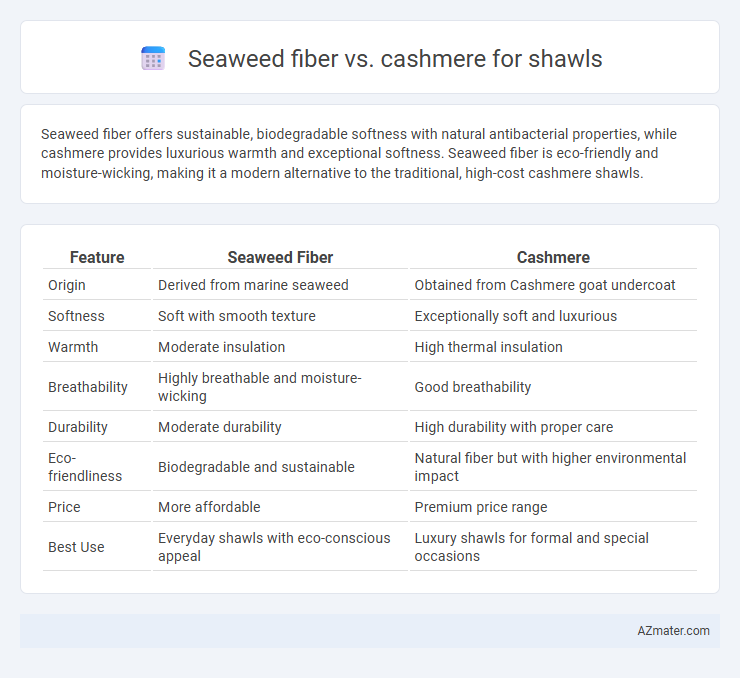Seaweed fiber offers sustainable, biodegradable softness with natural antibacterial properties, while cashmere provides luxurious warmth and exceptional softness. Seaweed fiber is eco-friendly and moisture-wicking, making it a modern alternative to the traditional, high-cost cashmere shawls.
Table of Comparison
| Feature | Seaweed Fiber | Cashmere |
|---|---|---|
| Origin | Derived from marine seaweed | Obtained from Cashmere goat undercoat |
| Softness | Soft with smooth texture | Exceptionally soft and luxurious |
| Warmth | Moderate insulation | High thermal insulation |
| Breathability | Highly breathable and moisture-wicking | Good breathability |
| Durability | Moderate durability | High durability with proper care |
| Eco-friendliness | Biodegradable and sustainable | Natural fiber but with higher environmental impact |
| Price | More affordable | Premium price range |
| Best Use | Everyday shawls with eco-conscious appeal | Luxury shawls for formal and special occasions |
Introduction: Comparing Seaweed Fiber and Cashmere for Shawls
Seaweed fiber offers sustainable, biodegradable properties and natural antibacterial benefits, making it an eco-friendly alternative to traditional shawl materials. Cashmere provides unmatched softness, warmth, and luxury derived from the undercoat of cashmere goats, favored for high-end shawls. Comparing thermal insulation, durability, and environmental impact reveals seaweed fiber as a renewable resource, while cashmere remains prized for its lightweight warmth and premium texture.
Origins and Sustainability of Seaweed Fiber
Seaweed fiber, derived from renewable marine algae, offers a sustainable alternative to traditional cashmere, which originates from the undercoat of cashmere goats primarily found in Mongolia and China. The production of seaweed fiber requires minimal water and no harmful chemicals, reducing its environmental footprint compared to cashmere, which often involves significant land use, water consumption, and greenhouse gas emissions. Seaweed fiber's rapid renewability and biodegradable properties contribute to eco-friendly fashion, addressing the sustainability challenges associated with cashmere shawls.
Cashmere: Sourcing and Environmental Impact
Cashmere shawls are sourced primarily from the undercoat of Cashmere goats, predominantly found in Mongolia, China, and Iran, where careful herding practices are essential to prevent overgrazing and desertification. The environmental impact of Cashmere production involves high water usage and greenhouse gas emissions, but sustainable initiatives like the Sustainable Fibre Alliance promote ethical farming and improved land management. Compared to seaweed fiber, which is renewable and biodegradable with low environmental footprint, Cashmere remains a luxury material valued for its softness and warmth despite environmental challenges.
Softness and Comfort: Seaweed Fiber vs. Cashmere
Seaweed fiber offers a unique softness with a smooth, silky texture that enhances breathability, making it ideal for lightweight and comfortable shawls. Cashmere is renowned for its plush, luxurious softness and excellent insulation, providing warmth and cozy comfort in cooler climates. Both fibers excel in comfort, with seaweed fiber delivering moisture-wicking properties and natural freshness, while cashmere ensures superior warmth and a rich tactile experience.
Warmth and Insulation Properties
Seaweed fiber offers excellent moisture-wicking and breathability, providing moderate warmth while naturally regulating temperature, making it suitable for mild to cool weather. Cashmere excels in insulation due to its fine, soft undercoat fibers that trap heat efficiently, delivering superior warmth ideal for cold climates. For shawls, cashmere remains the preferred choice when maximum insulation is desired, while seaweed fiber provides lightweight comfort with sustainable thermal regulation.
Breathability and Moisture Management
Seaweed fiber offers superior breathability for shawls due to its natural porous structure, allowing better air circulation compared to cashmere. It excels in moisture management by wicking sweat away from the skin, keeping the wearer dry and comfortable during extended use. Cashmere, while soft and warm, tends to retain moisture and offers less ventilation, making seaweed fiber a preferable choice for active or humid conditions.
Durability and Longevity of Shawls
Seaweed fiber shawls exhibit exceptional durability due to their natural resistance to wear and tear, maintaining texture and strength over time compared to cashmere. Cashmere, while luxuriously soft, tends to be more delicate and prone to pilling and fiber breakage with frequent use. Choosing seaweed fiber ensures enhanced longevity and sustained appearance, making it ideal for shawls designed for regular use.
Skin Sensitivity and Hypoallergenic Qualities
Seaweed fiber in shawls offers natural hypoallergenic properties and is highly suitable for sensitive skin due to its gentle texture and antimicrobial benefits. Cashmere, while incredibly soft and warm, may cause irritation for individuals with very sensitive skin owing to its animal protein content. Opting for seaweed fiber reduces the risk of allergic reactions and enhances comfort during prolonged wear.
Style Versatility and Aesthetic Appeal
Seaweed fiber shawls offer exceptional style versatility with their natural sheen and lightweight texture, making them ideal for both casual and formal wear, while cashmere shawls are renowned for their luxurious softness and classic elegance, often associated with timeless sophistication. Seaweed fiber's unique greenish hues and eco-friendly appeal enhance modern, nature-inspired aesthetics, contrasting with cashmere's rich, warm tones that complement traditional and high-end fashion. Selecting between seaweed fiber and cashmere depends on desired style flexibility and the distinct aesthetic statement one wishes to convey.
Price Point and Value Considerations
Seaweed fiber shawls generally offer a more affordable price point compared to cashmere, making them accessible for budget-conscious consumers seeking sustainable options. Cashmere provides unmatched softness and luxury, often commanding higher prices but delivering exceptional warmth and durability, which can justify the investment for long-term use. When evaluating value, seaweed fiber stands out for its eco-friendly benefits and moisture-wicking properties, while cashmere excels in timeless elegance and premium comfort.

Infographic: Seaweed fiber vs Cashmere for Shawl
 azmater.com
azmater.com